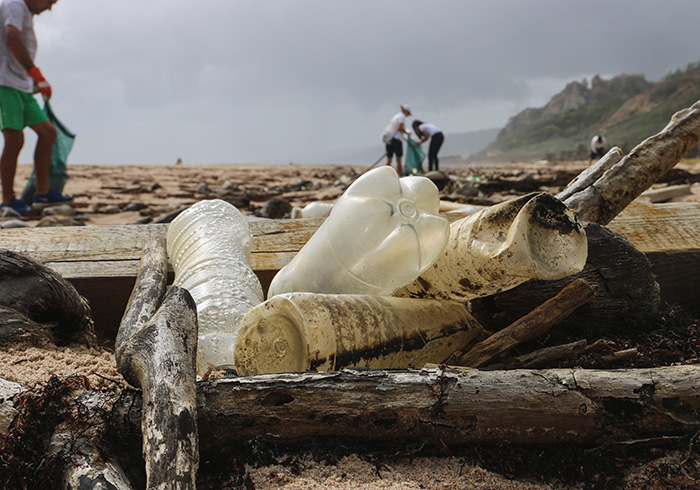Ending single use plastics would directly #MoveTheDate of Earth Overshoot Day by reducing the carbon emissions associated with plastics. However, the total effect on our planet’s biocapacity is unknown, but likely much larger.
What is the solution?
Reducing our use of single-use plastic food packaging by switching to re-use systems that use non-reactive (or inert) containers.
How does it #MoveTheDate?
Avoiding single-use plastic packaging reduces the currently overwhelming amounts of plastic entering the waste stream and prevents leakage into the environment. Storing and serving food and beverages in inert containers, such as steel and glass, also prevents the transfer of thousands of different chemicals that can leach out of plastic packaging into our food (and into the environment). Many of the known and unknown chemicals in plastic food packaging have been shown to be toxic even at low levels, and reducing exposure to them protects both human and environmental health.
How is it scalable?
Many different types of food packaging reuse systems have already been implemented locally around the world that demonstrate their feasibility and cost effectiveness. With small adaptations in distribution infrastructure, reuse systems can be shared and more widely implemented across regions or even entire business sectors.
What is the solution?
Reducing our use of single-use plastic food packaging by switching to re-use systems that use non-reactive (or inert) containers.
How does it #MoveTheDate?
Avoiding single-use plastic packaging reduces the currently overwhelming amounts of plastic entering the waste stream and prevents leakage into the environment. Storing and serving food and beverages in inert containers, such as steel and glass, also prevents the transfer of thousands of different chemicals that can leach out of plastic packaging into our food (and into the environment). Many of the known and unknown chemicals in plastic food packaging have been shown to be toxic even at low levels, and reducing exposure to them protects both human and environmental health.
How is it scalable?
Many different types of food packaging reuse systems have already been implemented locally around the world that demonstrate their feasibility and cost effectiveness. With small adaptations in distribution infrastructure, reuse systems can be shared and more widely implemented across regions or even entire business sectors.

The Earth’s life support systems are biological in nature and their ability to support humanity is called biocapacity. While we can’t easily quantify the effect of single use plastics, however, studies have shown that they remain in our land and ocean ecosystems long after they are disposed because they do not degrade easily. Negative impacts of plastic pollution have been documented in hundreds of species and likely occur across the planet, threatening the integrity of our life supporting ecosystems.
The Ellen Macarthur Foundation predicts that by 2050, there could be more plastic in the ocean than fish (by weight). The Great Pacific Garbage Patch, roughly the size of Alaska, is just one example of how plastic is affecting the planet’s oceans; with twenty-two tons of plastic entering our oceans every minute (1), plastics can be found on shorelines across the globe.
While recycling can be helpful, it is not a long term solution. Plastics can only be recycled a limited number of times at best, and certain types of plastic are not recyclable at all. Also, as documented in detail by the Food Packaging Forum, plastics are not only ecologically problematic but also for human health. The most sustainable solution is to avoid single-use plastics altogether.
Many initiatives which discourage the use of single-use plastics already exist around the world. In Paris, filtered water is available freely throughout the city; in high-traffic areas, reusable water bottles are sold in vending machines adjacent to water fountains. 500 European cities are working to replicate the Parisian system in their locales.(2)
In China, the China Biodiversity Conservation and Green Development Foundation (CBCGDF) formed the Reduce & Pickup Plastic Working Group to explore the problem of bottled water waste at the hundreds of meetings which take place across the country each year. In response to the considerable amount of waste generated by these meetings, the organization introduced the “Green Meeting Index”, a simple, easy-to-use framework that can be used to evaluate the sustainability of events such as conferences and exhibits. Since its introduction, the index has since been adopted by an increasing number of events, including international conferences.
(1) Paul Hawken, Regeneration (New York: Penguin Books, 2021), p.239.
(2) Ibid, p.237.
There’s no benefit in waiting!
Acting now puts you at a strategic advantage in a world increasingly defined by ecological overshoot. Countless solutions exist that #MoveTheDate. They’re creative, economically viable, and ready to deploy at scale. With them, we can make ourselves more resilient and #MoveTheDate of Earth Overshoot Day. If we move the date 6 days each year, humanity can be out of overshoot before 2050.
